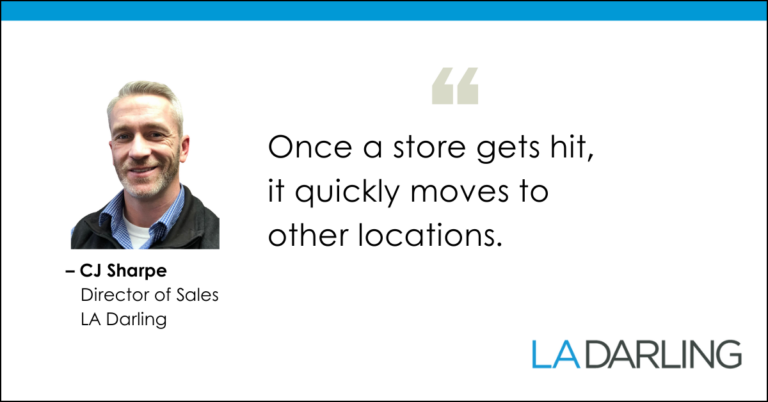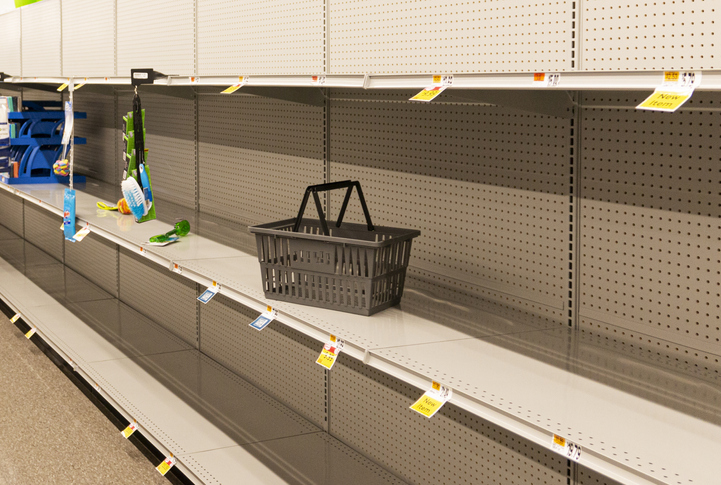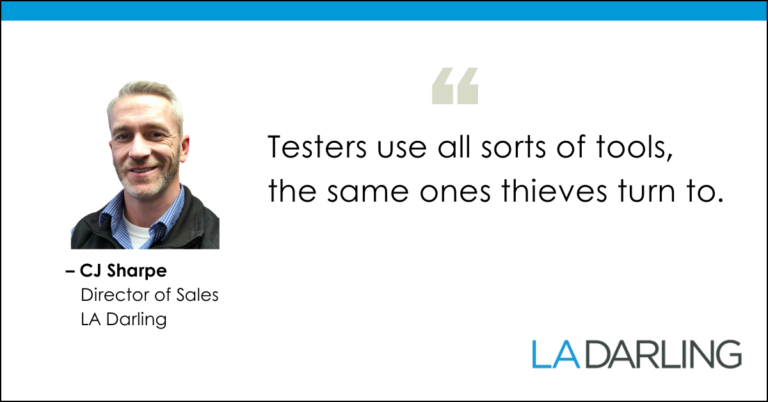Shoplifting, break-ins, and smash-and-grab events are no longer rare events but are happening with increasing frequency in retail outlets across the country. But how you respond after a theft incident can mean the difference between loss prevention and profit prevention.
In this blog we’ll take a look at how retailers can respond after a theft incident and effectively protect assets without disruption to store operation and customer experience. But first, a quick video on the matter:
What’s a typical retailer response after a break-in?
Retail theft is not only increasing in frequency, but it’s costly. According to Capital One Shopping research:
- From 2019 to 2020, the dollar value of retail theft losses increased 47.2%.
- Year over year, the dollar amount loss per shoplifting incident increased 71.2%.
But the losses might not be limited to the theft alone. According to CJ Sharpe, Director of Sales at L.A. Darling, the decisions you make after an incident can have costly consequences.
Let’s start with the ways retailers typically react:
Option #1: Cross your fingers and do nothing
You could just patch up the damage and carry on, hoping you won’t get hit again. However, if you have responsibility for multiple locations of one company, beware.

According to Sharpe, “Once a store gets hit, it quickly moves to other locations. You can expect that the same vulnerability that was breached in one location will be repeated in other stores in the chain within an area roughly 60 miles in radius.”
Word travels fast, so you’ll have to anticipate that losses will increase rapidly, and profits will drop.
Option #2: Enter ultra-protection mode
Instead of doing nothing, you may choose to go overboard with security measures. You might sweep all vulnerable products off the shelves and stash them somewhere in the back, far away from the eyes and hands of thieves–and customers.

But those empty shelves not only prevent customers from interacting with the product before making a buying decision, they also may be viewed as a signal that you’re out of stock, or worse, no longer selling those items.
When customers turn to a competitor to purchase items, there is the risk that they will discover they like the alternative, and you’ve lost a return customer.
Over-protecting merchandise may also prevent adequate engagement. Will customers make the extra effort to track down sales associates for help then wait for items to be freed in order to evaluate them or make a purchase–or will they just keep on walking to the competition?
Option #3: Protect assets and support the customer experience
You could choose a blend of both #1 and #2: Create new or modify existing custom security displays to offer shoppers efficient access to desirable products while guarding them against theft.
Security display cases allow customers to see that you have the product in stock and have an opportunity to interact with it. They can enhance the allure of merchandise and keep it highly visible yet secure.
Whatever path you take, the sense of urgency is real. You need to act quickly and decisively to regain control of the retail environment before shoppers go elsewhere or thefts increase.
How do you achieve a balanced security approach in practice?
To protect store assets without disrupting store operations, CJ Sharpe and L.A. Darling follow these basic principles:
- Assessment
- Design and modification
- Testing
- Adaptability
Assessment
Sharpe offers an example from one customer incident several years ago, which involved a secure cabinet installation with a cash stand on top. The configuration was built with an opening for cables associated with the cash system.
“The post-theft assessment revealed that thieves figured out how to gain access to the electronics on display in the case by using this opening,” Sharpe said.
Evaluating the damage and determining how the thieves conducted the theft is critical. In its assessment, L.A. Darling attempts to answer questions like:
- How did the thieves break in?
- What tools did they use?
- What time of the day or night did the theft occur?
Design and modification
After the assessment has been conducted, you may need a brand new solution. But not always.
Continuing with Sharpe’s cash-stand example, the L.A. Darling team addressed the problem with two remedies: They modified the opening and changed the locking mechanism.
This customized design process meant that security displays and cases could be paired with a wide variety of locking systems. “Shoppers retained the ability to see the products and store associates had a safer, more secure system of display,” Sharpe said.
Testing, testing, testing
Before a security case from L.A. Darling is installed, a team of in-house testers will do all they can to break into the case within a set time period. They will do anything and everything to find potential weak points and address them before offering it to the customer to test.

“Testers use all sorts of tools, the same ones thieves turn to–hammers, screwdrivers, crowbars and any hefty tool or object a thief could pick up from another part of the store. This is not quiet work–noise is not an issue,” says Sharpe.
Once the case has been modified, it is taken to the retailer, and their asset protection department has a go of it. Testing also extends to the effectiveness of the case as a display–how well it delivers protection without sacrificing easy operation for store personnel.
Adaptability
The security of the display doesn’t always end with the first install. When products on display in a store change, the security displays also need to be updated. Sharpe shared the example of a custom gun display for a client.
The unit was created to hold several different models of guns and was constructed to allow some customer access while keeping the products locked within the display.
But when new guns arrived for display with dimensions that didn’t fit within the current design of the case, the security had to be adapted. “Additional locking brackets were added to accommodate the different dimensions and prevent theft by way of the access points,” Sharpe said.
Get a plan (and get a vendor)
Don’t wait for dwindling store traffic to force you into a decision. Consider the options above on what you will do in the event a store theft occurs.
One thing you can do is line up the right supplier so you’re ready in the worst case scenario. Look for the following characteristics in a security case manufacturer:
Response time. An awareness and an understanding of urgency, starting with rapid prototyping, sample production and testing. Look for efficient production and timely delivery.
Experience. Tap into experience with many different products, retailers, and approaches to theft that can only be gained from repeated practice with creating helpful solutions.
Quality construction. Secure display cases must be designed to be used and capable of holding up under daily wear and tear. Mechanisms must work smoothly, without pinch points, and should cause sales associates no struggle or frustration to operate.
Rapid, effective response demonstrates a supportive customer response and reinforces the sense of trust within the organization.